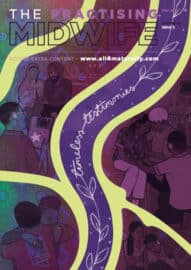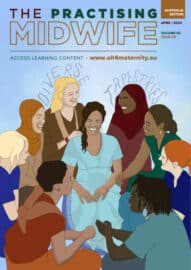Maternity in the Spotlight: Patient Safety Now
Dr Suzette Woodward [she/her] – Patient Safety Specialist
Twitter: @suzettewoodward
Summary
 Recent inquiries have provided an intense spotlight on maternity services. A key part of the response will be to rethink our approach to safety. We need to address the cultural and behavioural aspects of safety, increase our understanding of key aspects of safety, including complexity science and systems thinking, and build safer systems by understanding what functions and succeeds, rather than simply focusing on when it fails. The following blog will describe these new ideas and philosophies in more detail and make the case for changing safety in maternity services now.
Recent inquiries have provided an intense spotlight on maternity services. A key part of the response will be to rethink our approach to safety. We need to address the cultural and behavioural aspects of safety, increase our understanding of key aspects of safety, including complexity science and systems thinking, and build safer systems by understanding what functions and succeeds, rather than simply focusing on when it fails. The following blog will describe these new ideas and philosophies in more detail and make the case for changing safety in maternity services now.
Repeat recommendations
Over the last twenty years, despite concerted efforts across healthcare, the same mistakes keep happening. We know so much more but don’t seem to have made the impact you would expect. During this time there have been inquiries into paediatric surgery, implants, entire organisations and now within individual maternity units. Each inquiry results in a range of recommendations. Many of these recommendations are repeated. This raises difficult but important questions about what we should be doing differently.
What is it that we could be doing differently?
The first, and perhaps most important, is the need to address the cultural and behavioural aspects of safety. Our culture has been developed over time, sometimes over many generations. It is deeply rooted and remains even when people move on.
When someone says we need to change the culture we have to counter that with “what bit of the culture do you want us to change?”. because culture is made up of multiple components; our rituals, beliefs, language, customs, norms, attitudes and habits. It is different depending upon our gender, faith, ethnicity, background, character, sexuality and ability. It is also then impacted by the situations and circumstances we are placed into.
In healthcare, we have a problem of incivility, bullying and blame and some people find it hard to speak up and out. We can address these issues by:
- Developing a restorative just culture, where our immediate judgement is dispelled and instead, we seek to understand why individuals behaved in the way they behaved. We do so with kindness, respect and fairness. Our response should always be supportive. We ask people for their account and we take collective responsibility for dealing with it.
- Building a psychological safe environment where individual team members feel they belong to the team, can ask questions, can bring new ideas and challenge others without fear of repercussion.
- Building an environment that encourages people to speak up no matter who they are; to recognise that safety is built upon the collective diversity of everyone in the team and that we only achieve inclusion when the team is diverse and each individual feels safe to voice their thoughts and ideas.
People often ask, “where do I start?” My reply is always… it starts with you. It doesn’t cost anything for you to be kind, respectful and truly listen. It doesn’t cost anything for you to say thank you and let people know when they have done something lovely. The best and most successful workplaces ensure that people feel supported through difficult times. Compassionate and humble leadership at every level is key to all of this. If you set the tone and role-model these caring behaviours, others will want to follow.
The second thing we need to do is increase our understanding of key aspects of safety, this includes complexity science and systems thinking. Healthcare is a complex adaptive system which means that it is dynamic, changing and adapting all of the time and the people who work within it are expected to act accordingly. Yet if we don’t understand this and we study it as if it is a simple linear system, we can end up by providing solutions that are not fit for purpose.
Within our complex adaptive system there are three sub-systems identified by Vincent and Amalberti. These are ultra-adaptive, high reliability and ultra-safe.1
- Ultra-adaptive is where the situation calls for staff to be almost constantly adapting what they do. Examples include the emergency department, labour ward and general practice.
- High reliability is where we seek to avoid unnecessary risk and provide the same care consistently but at the same time recognise that there will always be risks and individual factors that may impact on that. Examples include surgery.
- Ultra-safe systems are where we want to prescribe in as much detail as possible because even tiny changes matter. Examples include radiotherapy, chemotherapy and microbiology.
Despite this model, our solutions have been ‘one size fits all’ and have not been tailored to the individual systems. People who work in them are left frustrated as they don’t fit the reality of their work. Complexity science and systems thinking forces us to consider the characteristics, variables, contributory factors and influences on the way people work.
Building on this, the third thing we should do is build safer systems by understanding what functions and succeeds, rather than simply focusing on when it fails. We need to move away from simply studying failure, an approach which has been termed by Hollnagel and colleagues as safety-I.2 Instead, we should study both failure and success, termed as safety-II. This is based on the premise that the vast majority of care provided goes well so, when it doesn’t, we ask ‘why did it fail this time, when most of the time it goes ok’.
There are reasons why things go wrong and crucially there are reasons why things go well. Yet we don’t learn in that way, we simply try to learn from our failures alone and therefore we are missing a whole area of learning and may be making things worse. If you change care based solely on failure you may well alter the conditions in which it succeeds.
In order to implement this new way of thinking there is a need to understand what peoples’ work is actually like, how the systems are functioning day-to-day. Shorrock3 and others have helped us distinguish the different aspects to our work and describes the difference and gap between ‘work as imagined’ (what people think you do), ‘work as prescribed’ (what they ask you to do) and ‘work as done’ (what you actually do):
- Work-as-done consists of adaptations and adjustments in order to keep people safe. People adapt and adjust their actions and decisions according to the patients they are caring for, the team they are working with, the resources they have, the conditions they work in and situations they face. The combination are rarely the same. However, we will only know what people actually do if they feel safe to speak up.
- Work-as-imagined refers to the people who regulate, inspect and design policies and interventions. If the people who are responsible for developing policies and procedures don’t understand the work-as-done then the guidance could turn out to be unworkable, incomplete or fundamentally wrong. In respect of safety solutions, if the developers don’t understand, consult and engage the frontline then they can develop the wrong solutions that won’t work. This all adds up to a situation where the policy or solution is considered to ‘solve the problems at the frontline’ and those on the frontline are left with the feeling that ‘this doesn’t solve our problems’.
- Work-as-prescribed is when there are clear rules and detailed instructions for carrying out tasks. In healthcare, some forms of prescribed work have become defunct but are still in place, some have drifted into mythology with people convinced that they are expected to work in a certain way which has in fact never been prescribed. With thousands of policies and procedures that exist in healthcare we need to make sure they are clear, succinct and up to date – but also have a caveat that says ‘this policy may be adapted depending upon the circumstances faced’.
The gaps between these three aspects of work make it hard for frontline staff to implement things they are being told to do, resulting in frustration and workarounds. It is costly and demoralising. The unintended consequence of this is that it triggers fatigue in relation to initiatives that seem misaligned with the goals of day-to-day work, creating a chasm between the leadership and frontline.
Safety-II helps us drive a much more positive approach to safety, helps us understand how the systems and people within those systems are functioning and what we can do to build on success and prevent the failures from happening. Dekker and Conklin say change happens through learning and when people are exposed to a new way of thinking.4
I sincerely hope that this blog has inspired you to learn more about these new ideas and philosophies.
Author
Suzette is a visiting professor of patient safety at Imperial College and a national clinical advisor on patient safety and author of two books on patient safety, with the third, Patient Safety Now, being published in October 2022. A former paediatric intensive care nurse with over 40 years in the NHS, she has worked for over 20 years of that in patient safety at a national and international level. Suzette has held executive board posts at the National Patient Safety Agency and NHS Resolution and advisory roles with Department of Health and Social Care and Public Health England. She has a Doctorate in Patient Safety, an honorary Doctorate of Science and a masters in clinical risk.
References
- Vincent C, Amalberti R. Safer Healthcare: Strategies for the Real World. Springer; 2016. doi:10.1007/978-3-319-25559-0
- Hollnagel E, Braithwaite J, Wears RL. Resilient Health Care. Surrey England: Ashgate Publishing Limited; 2013 doi:1093/intqhc/mzv063
- Shorrock S. https://humanisticsystems.com/author/stevenshorrock/ Published 2022.
- Dekker S, Conklin T. Do Safety Differently. Santa Fe, New Mexico: Pre Accident Media; 2022.








